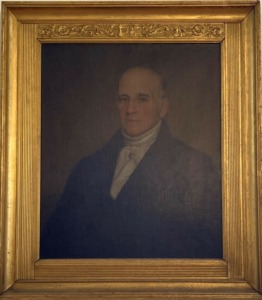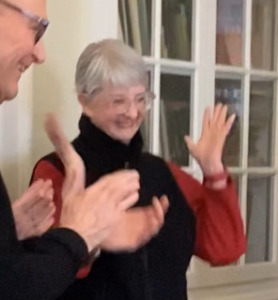 A former Lenox resident now living in Virginia spotted a painting for sale on EBay. This was the listing:
A former Lenox resident now living in Virginia spotted a painting for sale on EBay. This was the listing:
“Here is a very important Oil on Canvas Of the Honorable William Perrin Walker (1778-1858) who was a sitting judge of Berkshire County Massachusetts (1824-1848), and father to Cornelia Walker Scranton, who married Joseph Hand Scranton, one of the 3 founding fathers of Scranton, PA.
He resided in Lenox, MA.
It is in excellent condition, free of issues with the oil or the frame, 100% original. It is very large and heavy, measuring 40″ high, 35″ wide, 4″ deep and weighs 27 pounds. It could use a light cleaning, I am selling it exactly as I recently found it from an estate. This was purchased from the Scranton family in 1981, when the Scranton Mansion in Scranton PA was divided up after Governor William Scranton’s death (his great-grandson).
This is a very important piece of early Massachussett history, for both Lenox and Berkshire county and I hope that it finds it way back there, maybe in a museum.
This is a local estate find here in the Endless Mountains region of Northeast Pa and has not been offered on the market before.”
In order to verify the subject of the painting, Local History Librarian Amy Lafave forwarded the email to Lucy Kennedy. Lucy had taken a photograph of a black and white reproduction of a painting of Judge Walker on the walls of the Berkshire County Court House in Pittsfield for use on http://lenoxhistory.org. As it turns out, the painting on EBay matched the black and white version at the Court House.
Who was William Perrin Walker? In Memorial of the Walkers of the Old Plymouth Colony, he was described as “…one of the most prominent of the old Jeffersonian party in Western Massachusetts. Over six feet in height (6 ft. 3 in.) and well proportioned, his personal appearance and manners were uncommonly dignified and elegant. Refinement, delicacy and courtesy were his marked characteristics. He had quick discernment and penetrating judgment. Generous and hospitable, mild, candid, affectionate and amiable, his influence in the community was very great and all looked up to him for counsel and paid him the highest respect. His dispatch in business was remarkable. As a Judge, he was courteous, patient, dispassionate, intelligent and impartial.”

1842 farm book of William P. Walker contains an entry for “Cornelia’s wedding”
Why would a portrait of a Berkshire County judge end up in Scranton, PA? Judge Walker’s daughter Cornelia married Joseph Hand Scranton, one of the city’s founders, who commissioned the building of a mansion in 1871, known as The Estate. Worthington Scranton donated The Estate to the University of Scranton in 1941 (not 1981), and planned to disperse the contents, including pictures, to various family members. In 2011, the Lackawanna Historical Society arranged for the transfer of some other Walker family portraits to the Lenox Historical Society, including an oil painting of W.P. Walker’s father, Judge William Walker, that were then owned by the family of former Pennsylvania Governor William Scranton, Worthington’s son. However, for some reason, this painting was not part of that transfer.
The gilt frame for the portrait is of more recent vintage; there is a carved detail with Judge Walker’s initials and dates of birth and death, and the canvas is held in place with machine-cut brads. The portrait of the first Judge Walker is framed in the same way.
How the paintings got to Scranton is still a mystery. The portraits are not listed in any of the wills for either judges or their wives. But in looking through the copious Walker family material in the library’s archives, we did find other items that tell a story. For instance, we have the Assessors Records for the Town of Lenox in 1798, in which William Walker was assessed for 2 houses, 200 acres improved land (and 90 acres woodland), ½ of a sawmill, 11 horses, 14 cows, and 1 watch among other things, totaling $4,424 in real estate and $1,186.60 in personal property.
The ‘farm records’ kept by William Perrin Walker in 1842 contains an entry for Tuesday, July 13: “Cornelia’s wedding.” It is surrounded by entries of work performed by “Jos.” – mowing, potatoes, and other gardening chores. Jos. is most likely Joseph Schermerhorn, believed to be a freed slave from New York State, who lived on Hubbard Street. Another entry mentions Jos. going to Kinderhook. We continue to unearth materials which tie both Walker families to old Dutch families of the Kinderhook area, trying to untangle the thread between them and the people of color who lived in 19th century Lenox – many with Dutch last names.
 How did the painting come back to Lenox? Lucy Kennedy decided that she would buy the painting. and she donated it to the Lenox Library Association. In a brief unveiling ceremony (with cookies provided by Loeb’s Foodtown), LLA Board President Edward Richter accepted the generous gift. The painting now hangs above the mantle in the Legacy Room, back in the court house where William Perrin Walker held court when Lenox was the shire town. And yes, it definitely needs a cleaning.
How did the painting come back to Lenox? Lucy Kennedy decided that she would buy the painting. and she donated it to the Lenox Library Association. In a brief unveiling ceremony (with cookies provided by Loeb’s Foodtown), LLA Board President Edward Richter accepted the generous gift. The painting now hangs above the mantle in the Legacy Room, back in the court house where William Perrin Walker held court when Lenox was the shire town. And yes, it definitely needs a cleaning.

